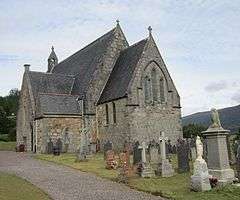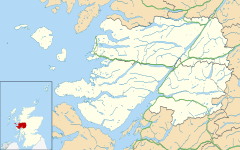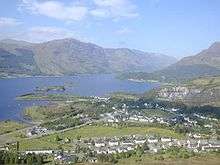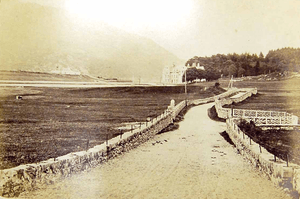Ballachulish
The village of Ballachulish (/ˌbæləˈxuːlɪʃ/ BAL-ə-KHOO-lish or /ˌbæləˈhuːlɪʃ/ BAL-ə-HOO-lish, from Scottish Gaelic Baile a' Chaolais [baləˈxɯːl̪ˠɪʃ]) in Lochaber, Highland, Scotland,[1] is centred on former slate quarries. The name Ballachulish (Ballecheles, 1522 – Straits town,[2]) was more correctly applied to the area now called North Ballachulish, to the north of Loch Leven, but was usurped for the quarry villages at East Laroch and West Laroch, either side of the River Laroch, which were actually within Glencoe and South Ballachulish respectively.
Ballachulish
| |
|---|---|
 St. John's Church | |
 Ballachulish Location within the Lochaber area | |
| OS grid reference | NN061579 |
| Council area | |
| Country | Scotland |
| Sovereign state | United Kingdom |
| Post town | Ballachulish |
| Postcode district | PH49 |
| Dialling code | 01855 |
| Police | Scotland |
| Fire | Scottish |
| Ambulance | Scottish |
Overview

The principal industry is now tourism, although most visitors pass swiftly by the village itself.
The name Ballachulish (from Scottish Gaelic, Baile a' Chaolais) means "the Village by the Narrows". The narrows in question is Caolas Mhic Phàdraig - Peter or Patrick's son's narrows, at the mouth of Loch Leven.
As there was no road to the head of Loch Leven until 1927, the Ballachulish Ferry, established in 1733, and those at Invercoe/Callert and Caolas na Con were essential. The Ballachulish ferry closed in December 1975 when the Ballachulish Bridge finally opened.
The Ballachulish Hotel and Ballachulish House (until recently [2010] a country house hotel) are located near the narrows at (south) Ballachulish Ferry rather than in the "modern" village some 3 miles (5 km) east. Ballachulish House was reputed to be haunted, and the drive leading to it was ridden by a headless horseman.
| Pronunciation | ||
|---|---|---|
| Scots Gaelic: | Baile a' Chaolais | |
| Pronunciation: | [baləˈxɯːlˠ̪ɪʃ] | |
| Scots Gaelic: | Gleann a' Chaolais | |
| Pronunciation: | [klan̪ˠəˈxɯːl̪ˠɪʃ] | |
| Scots Gaelic: | Gleann Bhaile Chaoil | |
| Pronunciation: | [klan̪ˠ valə ˈxɯːl] | |
| Scots Gaelic: | Iain Cealaidh | |
| Pronunciation: | [ˈiaɲ ˈkʲʰal̪ˠɪ] | |
| Scots Gaelic: | Beinn a' Bheithir | |
| Pronunciation: | [peɲəˈve.ɪɾʲ] | |
The hamlet of Glenachulish lies in Gleann a' Chaolais, the glen that runs down to the narrows. This is the subject of the Gaelic song, Gleann Bhaile Chaoil written by John Cameron (1865–1951)[3] and known locally both as the Paisley Bard and by his local nickname Iain Cealaidh. He is often confused with another local bard also called John Cameron, known locally as Iain Rob (1822–1898).[4] Gleann a' Chaolais is ringed by Beinn a' Bheithir, a massif which contains two munros - Sgorr Dhearg and Sgorr Dhonuill. In recent years a number of new houses have been built locally along with holiday chalets and an art gallery. Also the fields of Gleann a' Chaolais have been turned into the 9-hole Dragon's Tooth golf course.
Overlooking the narrows is the monument to James of the Glen, "hanged on this spot for a crime of which he was not guilty". Robert Louis Stevenson based his novel Kidnapped around the story of the Appin Murder. Whoever did kill The Red Fox (Campbell of Glenure) is still not known.
Shinty
Shinty is a popular local sport and the narrows is the traditional boundary of the north–south divide in shinty, with teams north of narrows playing in the North district's competitions and those South playing in their respective competitions. Ballachulish Camanachd Club play in the South Leagues. However, Ballachulish is still considerably far North in relation to most of Scotland. The club has won the Camanachd Cup four times.
Railway

In 1903, a branch of the Callander and Oban Railway, from Connel Ferry, was opened to Ballachulish. The site of the former railway halt of Ballachulish Ferry, the penultimate stop on the line before the Laroch quarries, was next to Ballachulish House, some 1⁄2 mile (800 m) inland from the ferry. Traces of the line, which closed in 1966, remain between here and Connel Ferry. The old terminus station at Laroch (Ballachulish) is now a doctor's surgery. The station, and stationmaster's house, at Duror, is now a private house and the station at Creagan, some 20 miles (30 km) south, has been refurbished in its old traditional Caledonian Railway brown. The station at Kentallen (5 miles (8 km) south of Ballachulish) included a pier. When the Oban-Ballachulish branch line closed, the station buildings were bought over by Scottie & Bridget Stewart who ran the renowned Kentallen Station Tearooms for more than 15 years until finally retiring in 1974. Afternoon tea served here was a spectacular feast according to visitors books from the day. This station has now been turned into The Holly Tree Hotel & Leisure Club. Much of the old railway line has been re-used as part of National Cycle Route 78, once again giving the beautiful views previously seen from the train.
Slate
Slate from the East Laroch quarries, established just two years after the infamous Glencoe Massacre of 1692, was used to provide the roofing slate for much of Edinburgh and Glasgow's skyline in the succeeding centuries. It is of good quality but one weakness is the presence of Iron Pyrite in the rock. These crystals quickly rust away when exposed to the weather, leaving clean square holes and a brown rusty streak. Over 75% of the slate cut from the quarries was unusable as roof covering for this and other reasons. The quarries closed in 1955. Optimistically, tests have recently (2008/9) been carried out to see if it is feasible to extract slate from them again.
Between 1902 and 1905 the Ballachulish community was badly affected by two protracted conflicts in the slate quarries. The first began in July 1902, involved a twelve months lockout, and lasted eighteen months. The workers objected to the summary dismissal of the medical officer Dr. Lachlan Grant from both his work in the quarries and his post as Medical Officer for the Parish Council District of Ballachulish. They also objected to the unsatisfactory labour contracts, inadequate wages and excessive charges for the powder, coals and other materials supplied by the company. The second dispute started in the summer of 1905 when members of a hostile crowd charged the quarry manager with autocratic, dictatorial and unfair behaviour towards both Dr. Grant and members of the quarrying labour force and the community. A new company was formed in December 1907 and quarrying continued at Ballachulish until 1955.[5]
Local Highland Games
On Saturday last these games were held under the most favourable auspices. The competitions were confined to local athletes - competitors from Ballachulish, Glencoe, Onich, Ardgour and Duror alone being eligible. This allowed a pleasant rivalry in feats of skill between youth of the neighbouring districts and encouraged a fondness for outdoor sports.
The Ballachulish Men excelled in throwing the hammer and putting the stone and the Glencoe men in leaping and racing, while the Lochaber (Onich) men carried off the place for vaulting with the pole, one of them clearing a height of 8 feet 8 inches and would have done more if required. The Glencoe lads are keener athletes than the Ballachulish ones. They stand almost unequalled at the game of shinty and on Saturday a plucky Glencoe lad was to be seen at every contest, no matter what his chances of winning might be. The Ballachulish lads are muscular and strong and should give a good account of themselves in any fray; but they do not show the same amount of Celtic fire for field sports as their neighbours of Carnoch (Glencoe).
Music was supplied by the pipe band of F Company (A.H.R.V.) and added greatly to the enjoyment of the day. The committee of judges were:- Messrs A. Beatson Bell, D. Campbell, J.B. Chinery Haldane, Major-Gen. Macpherson, D. McCalman, W.H.S. Napier, R. Philips and F.S. Robertson. The difficult duty of judging the dancing and pipe music was kindly and satisfactorily performed by Mrs. Robertson, Callart, and Major-Gen. Macpherson assisted by Mr. McIver, Callart House, in the latter case.
Events were - Hammer; Stone; High jump; Vaulting with pole; Long race; Boys' race; Short race; Sack race; Three-leg race; Pipe music; Highland Fling; Reels; Sword dance; Hornpipe.
— The Oban Times, 5 Sept. 1885
The contrast between the local informal competitions and the more formal 'arranged' games can be traced through to the second half of the century. Into the former category could be placed events such as the Ballachulish regatta 'got up by working men' at the slate quarries, which was accompanied by land sports. At these gatherings the traditional sports - throwing the hammer and the stone (both heavy and light), racing and leaping (high jump and long jump) - were pursued as 'trials of strength, swiftness and agility'...The caber seldom featured in local informal sports events arranged by local people as distinct from formal Highland Gatherings stage managed by non-locals.
— Lorna Jackson, Sport in the Making of Celtic Cultures[6]
Graveyard
The graveyard of St John's Episcopal Church has some fine gravestones which, unlike many others, look as if they were engraved "yesterday", having been made from Ballachulish slate.
See also
References
- Microsoft; Nokia (1 April 2017). "Ballachulish" (Map). Bing Maps. Microsoft. Retrieved 1 April 2017.
- Place Names; Highlands and Islands of Scotland by Alex. MacBain, M.A., LL.D. Eneas MacKay, 43 Murray Place, Stirling, 1922
- The Oban Times, 14 July 1951
- The Oban Times, 26 November 1898. The Highland News, 26 Nov. 1898.
- Custom and Conflict in 'The Land of the Gael': Ballachulish 1900-1910. by Neville Kirk. The Merlin Press Ltd. 2007.
- Lorna Jackson, Chapter three in Sport in the Making of Celtic Cultures (1999) edited by Grant Jarvie, Leicester University Press, Wellington House, 125 Strand, London WC2R 0BB
| Wikimedia Commons has media related to Ballachulish. |